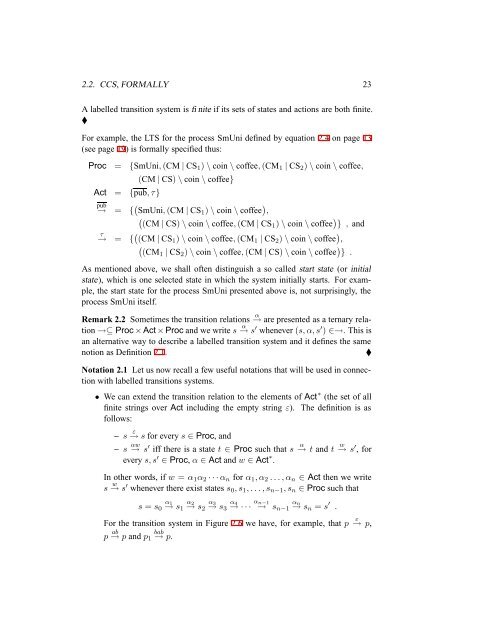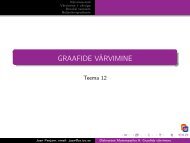Reactive Systems: Modelling, Specification and Verification - Cs.ioc.ee
Reactive Systems: Modelling, Specification and Verification - Cs.ioc.ee
Reactive Systems: Modelling, Specification and Verification - Cs.ioc.ee
Create successful ePaper yourself
Turn your PDF publications into a flip-book with our unique Google optimized e-Paper software.
2.2. CCS, FORMALLY 23<br />
A labelled transition system is finite if its sets of states <strong>and</strong> actions are both finite.<br />
<br />
For example, the LTS for the process SmUni defined by equation 2.4 on page 13<br />
(s<strong>ee</strong> page 19) is formally specified thus:<br />
Proc = {SmUni, (CM | CS1) \ coin \ coff<strong>ee</strong>, (CM1 | CS2) \ coin \ coff<strong>ee</strong>,<br />
Act = {pub, τ}<br />
(CM | CS) \ coin \ coff<strong>ee</strong>}<br />
pub<br />
→ = { SmUni, (CM | CS1) \ coin \ coff<strong>ee</strong> ,<br />
(CM | CS) \ coin \ coff<strong>ee</strong>, (CM | CS1) \ coin \ coff<strong>ee</strong> } , <strong>and</strong><br />
τ<br />
→ = { (CM | CS1) \ coin \ coff<strong>ee</strong>, (CM1 | CS2) \ coin \ coff<strong>ee</strong> ,<br />
(CM1 | CS2) \ coin \ coff<strong>ee</strong>, (CM | CS) \ coin \ coff<strong>ee</strong> } .<br />
As mentioned above, we shall often distinguish a so called start state (or initial<br />
state), which is one selected state in which the system initially starts. For example,<br />
the start state for the process SmUni presented above is, not surprisingly, the<br />
process SmUni itself.<br />
Remark 2.2 Sometimes the transition relations α → are presented as a ternary relation<br />
→⊆ Proc × Act × Proc <strong>and</strong> we write s α → s ′ whenever (s, α, s ′ ) ∈→. This is<br />
an alternative way to describe a labelled transition system <strong>and</strong> it defines the same<br />
notion as Definition 2.1. <br />
Notation 2.1 Let us now recall a few useful notations that will be used in connection<br />
with labelled transitions systems.<br />
• We can extend the transition relation to the elements of Act ∗ (the set of all<br />
finite strings over Act including the empty string ε). The definition is as<br />
follows:<br />
– s ε → s for every s ∈ Proc, <strong>and</strong><br />
– s αw → s ′ iff there is a state t ∈ Proc such that s α → t <strong>and</strong> t w → s ′ , for<br />
every s, s ′ ∈ Proc, α ∈ Act <strong>and</strong> w ∈ Act ∗ .<br />
In other words, if w = α1α2 · · · αn for α1, α2 . . . , αn ∈ Act then we write<br />
s w → s ′ whenever there exist states s0, s1, . . . , sn−1, sn ∈ Proc such that<br />
s = s0<br />
α1 α2 α3 α4<br />
→ s1 → s2 → s3 → · · · αn−1<br />
→ sn−1 αn<br />
→ sn = s ′ .<br />
For the transition system in Figure 2.6 we have, for example, that p ε → p,<br />
p ab<br />
→ p <strong>and</strong> p1 bab<br />
→ p.
















